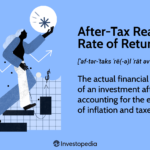What Is Absorption Rate?
Absorption rate most commonly refers to a metric used in the real estate market to evaluate the rate at which available homes are sold in a specific market during a given time period. It is calculated by dividing the number of homes sold in the allotted time period by the total number of available homes. This equation can also be reversed to identify the amount of time it would take for the supply to be sold.
Absorption rate is also a key part of the accounting industry. In this context, absorption rate refers to the way in which businesses calculate their overhead costs.
Key Takeaways
- The absorption rate is commonly used in the real estate market to determine how many homes are sold in a market at a particular time.
- The equation can also be used to figure out how long it would take to sell the supply of homes on the market.
- Realtors, appraisers, and lending institutions use absorption rates to understand market conditions and adjust terms accordingly.
- An absorption rate above 20% typically signals a seller’s market and an absorption rate below 15% is an indicator of a buyer’s market.
- Absorption rates are also used to determine and allocate overhead costs in accounting.
Understanding Absorption Rate
Absorption rate provides insight into how quickly or slowly houses are selling in the real estate market. Absorption rate does not take into account additional homes that enter the market at various times. While an absorption rate calculation can be projected, it’s most commonly used based on current available data and actual inventory.
A high absorption rate may indicate that the supply of available homes will shrink rapidly. A homeowner is typically able to sell their property faster during periods of high absorption. However, the time period associated with an absorption rate calculation is important to consider.
Traditionally, an absorption rate above 20% signaled a seller’s market in which homes are sold quickly. An absorption rate below 15% is an indicator of a buyer’s market in which homes are not being sold as fast.
Real estate professionals, such as brokers, use the absorption rate in pricing homes. During periods of higher absorption rates, homes are often priced higher.
Influence in the Real Estate Market
In market conditions with low absorption rates, a real estate agent may be forced to reduce a listing price to entice a sale. Alternatively, the agent can increase the price without sacrificing demand for the home if the market has a high absorption rate. The absorption rate is also important for buyers and sellers to follow as they make decisions on the timing of purchases and sales.
The absorption rate is also a signal for developers to start building new homes, though developers often use long lead times to forecast periods of higher absorption. During market conditions with a high absorption rate, demand may be high enough to warrant the further development of properties. Meanwhile, periods with lower absorption rates indicate a cooling period for construction.
Appraisers use the absorption rate to determine the value of a property. Some procedures require an addendum showing that absorption rates were considered in appraisal calculations. In general, appraisers are responsible for analyzing market conditions and maintaining an awareness of the absorption rates for all types of appraisal values.
Most appraisers include this data metric in the neighborhood section of the appraisal forms. The current valuation of a home would be reduced during periods of decreased absorption rates and increased when absorption rates are high.
Lenders and banking institutions will also consider market conditions when evaluating loan and credit terms. During periods of low absorption, banks may feel tempted to entice clients to borrow money with more favorable loan terms. Alternatively, lenders can be more selective during high absorption periods as they are more likely to have a broader portfolio of prospective borrowers.
Example of the Absorption Rate
Suppose a city has 1,000 homes currently on the market to be sold. If buyers purchase 100 homes per month, the absorption rate is 10% (100 homes sold per month divided by 1,000 homes available for sale). This also indicates that the supply of homes will be exhausted in 10 months (1,000 homes divided by 100 homes sold/month).
Want to know if it’s time to sell your home? Look up the number of homes sold in your area from the MLS website and use the formula above to determine how long it will take to sell your property.
Absorption Rate in Accounting
Absorption rate is also used in an entirely different manner in accounting.
In accounting, absorption rate (or the rate of absorption) is the rate at which companies calculate and allocate their overhead expenses. These are the costs associated with providing goods and services to their customers, though these expenses aren’t directly traceable to end products. As such, it’s also often called an overhead absorption rate.
Companies often have to use estimates to determine their overhead costs. That’s because they don’t know what the actual costs are until they come in. In order to determine their overhead, companies divide the total budgeted overhead costs divided by the total budgeted production base. This requires an adjustment at the end of the accounting period to make up for any difference between the predicted and actual costs.
Alternatively, a company may know its actual overhead costs but not know how to trace those costs to final products or services. To overcome this hurdle, companies use estimated cost drivers to guess what non-financial measures cause changes in financial measures.
This can be problematic, especially when companies use very conservative estimates to predict their costs. Doing so may throw off their balance sheets because the actual costs may be higher at the end of the reporting period or if costs fluctuate. However, this practice has the benefit of making sure all costs including estimated amounts and estimated allocations are included when evaluating their products.
What Does Absorption Rate Mean?
Absorption rate is most often associated with real estate and the rate at which houses are being bought. Absorption rate (and absorption costing) are also used in cost accounting to assign overhead costs.
What Does a High Absorption Rate Mean?
A high absorption rate means a higher proportion of houses are being purchased. Otherwise, a low absorption rate means a lower proportion of houses are being purchased. This information is used by relators, financial institutions, and appraisers as the rate at which houses are being bought drives a home’s value and price.
What Is the Formula for Absorption Rate in Real Estate?
To find out the absorption rate in real estate, divide the total number of homes sold in a specific period of time by the total number of homes available in that market.
What Is a 6-Month Absorption Rate?
Absorption rates indicate how long it takes to sell homes in a given market. A six-month absorption rate indicates a balanced market, so buyers and sellers equally benefit during this environment.
How Do You Calculate a Monthly Absorption Rate?
In order to determine a monthly absorption rate, take the total number of homes sold in the market and divide that by 12. Then, divide this monthly average number of homes sold by the total number of homes available for sale.
The Bottom Line
The absorption rate is a very important metric used in the real estate and accounting.
Realtors use it to determine how many homes are sold in a particular area at any given time. These professionals can also use the rate to determine the kind of market they are facing, whether that’s a buyer’s, seller’s, or a balanced market. This rate is also important for the construction industry, as it indicates when developers should start buying.
Equally important, absorption rate is used in the accounting field—notably for companies to estimate their overhead. Absorption costing entails estimating overhead costs, determining overhead cost drivers, and having products absorb these untraceable costs.



